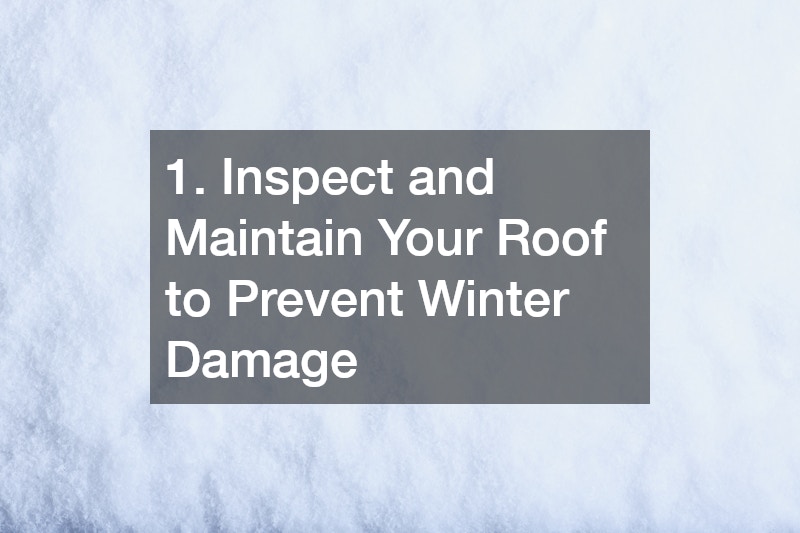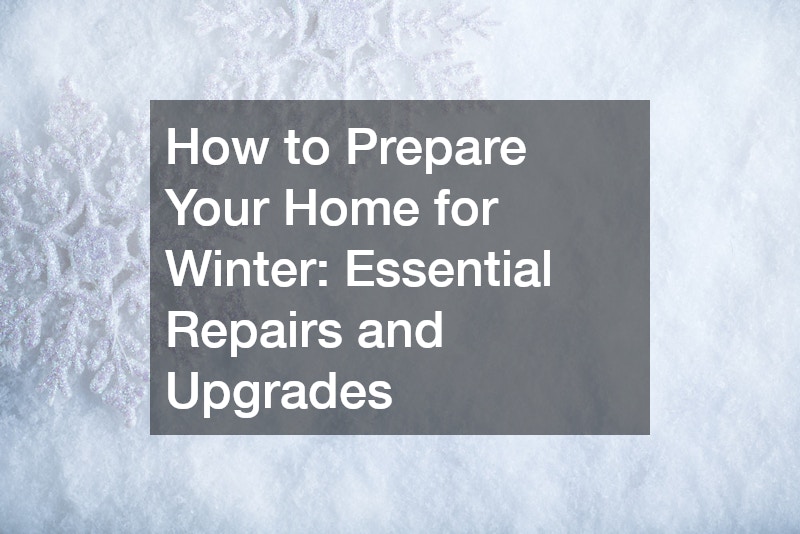Winter brings cozy evenings by the fireplace, hot drinks, and the beauty of snow-covered landscapes—but it also comes with unique challenges for homeowners. Cold temperatures, ice, snow, and high winds can take a serious toll on your home if you aren’t properly prepared. From frozen pipes and leaky roofs to inefficient heating systems and exterior wear, the winter months can amplify small maintenance issues into costly problems.
Taking a proactive approach to winter preparation not only protects your home but also keeps your family safe, comfortable, and energy-efficient. By systematically inspecting your home, addressing potential weak points, and upgrading essential systems, you can avoid emergency repairs and enjoy a stress-free season.
This guide provides actionable tips and practical advice to help you safeguard your home—from the roof to the yard—so you’re fully ready for whatever winter throws your way.
Winter readiness also means planning ahead. By preparing your home early, you avoid the rush that comes with the first cold snap. Scheduling inspections, repairs, and professional services in advance ensures you have the time to address any issues properly. Waiting too long can mean longer wait times for contractors, higher repair costs, and more stress when winter arrives.
1. Inspect and Maintain Your Roof to Prevent Winter Damage

Your roof is your home’s first line of defense against winter weather. Ice, snow, and heavy winds can exacerbate existing issues or create new ones, making a thorough inspection essential before the first snowfall.
Actionable Tips:
- Check shingles and flashing: Look for loose, cracked, or missing shingles. Replace or repair any that are damaged. Inspect flashing around chimneys, vents, and skylights to prevent leaks.
- Clean gutters and downspouts: Blocked gutters can lead to ice dams, which trap water and can cause leaks or structural damage. Remove debris and ensure water flows freely.
- Inspect attic insulation and ventilation: Poor insulation can lead to ice dams and increased heating costs. Ensure your attic is properly insulated and ventilated.
- Look for structural issues: Sagging areas, cracks, or water stains on ceilings may indicate underlying damage. Schedule professional repairs if necessary.
For exterior wall maintenance and added protection, a local stucco company can assess your home for cracks or deterioration in stucco, which often worsens during winter. Early repairs prevent moisture infiltration that could affect the roof and interior walls.
In addition, consider trimming nearby trees or branches that could fall on your roof during heavy snow or ice storms. Removing overhanging limbs reduces the risk of damage and helps keep gutters cleaner. Snow guards or heat cables may also be added to prevent ice dams, ensuring your roof continues to protect your home throughout the season.
2. Keep Your Heating System Efficient and Reliable
A functioning heating system is critical during winter. Cold snaps can put enormous strain on your furnace, so proactive maintenance is essential.
Actionable Tips:
- Schedule a furnace inspection: A professional can clean, tune, and check your system for safety and efficiency. This reduces the risk of breakdowns during peak cold.
- Change or clean filters: Dirty filters reduce efficiency and air quality. Replace filters every 1–3 months.
- Check thermostat settings: Ensure programmable thermostats are working correctly and set to optimize energy use.
- Inspect ductwork: Look for leaks, loose connections, or blockages that reduce airflow and efficiency.
If repairs are needed, a professional furnace repair technician can address issues before they become emergencies. An experienced HVAC contractor can also recommend system upgrades or adjustments to handle prolonged winter usage more efficiently.
Regular maintenance goes beyond keeping the system running—it can extend the lifespan of your furnace and help prevent dangerous malfunctions, such as carbon monoxide leaks. Winter-ready heating systems also improve energy efficiency, which translates to lower utility bills. By addressing these steps before the cold hits, you ensure warmth and safety for your entire household.
3. Prepare Your Plumbing and Hot Water Systems
Winter can wreak havoc on plumbing, particularly when pipes freeze. Taking precautions now can save you from costly damage and inconvenience.
Actionable Tips:
- Insulate exposed pipes: Wrap pipes in unheated areas like basements, garages, and crawlspaces. Use foam insulation or heat tape for extra protection.
- Drain outdoor hoses and irrigation lines: Prevent freezing and bursting by draining and storing hoses indoors.
- Flush the hot water heater: Sediment buildup reduces efficiency and increases the risk of leaks. Regular maintenance keeps your system running smoothly.
- Check water pressure: Extremely high pressure can stress pipes during freezing temperatures. Consider a pressure regulator if necessary.
During winter, it’s wise to have a professional inspect your hot water heater repair needs before problems arise. Additionally, installing an emergency generator ensures you have hot water and running plumbing even during power outages caused by winter storms.
Another helpful tip is to leave cabinet doors under sinks open during particularly cold nights. This allows warm air from your home to circulate around pipes and reduces the chance of freezing. Combining preventative measures with professional inspections provides peace of mind and prevents emergency plumbing issues during the coldest months.
4. Protect Your Chimney and Fireplace for Safe Heating

Fireplaces are a classic winter comfort, but they also require attention to prevent hazards. A clean and well-maintained chimney ensures efficient heating and reduces fire risk.
Actionable Tips:
- Schedule chimney sweeping: Remove creosote buildup, debris, and blockages that could ignite or impede airflow.
- Inspect chimney caps and flues: Check for cracks, loose bricks, or signs of water damage. Proper sealing prevents leaks and animal intrusion.
- Keep the hearth safe: Clear combustible materials around the fireplace and ensure tools are in good condition.
- Check smoke and carbon monoxide detectors: Ensure all alarms are working before using the fireplace extensively.
Many homeowners pair chimney maintenance with furnace repair to ensure all heating systems are operating safely and efficiently. Regular inspections by professionals prevent dangerous backups, reduce fire risks, and improve overall home warmth.
For added safety, consider installing a fireplace screen or glass doors to prevent sparks from reaching carpets or furniture. Ensuring your chimney and fireplace are in top condition can also improve heating efficiency, reducing reliance on other systems and lowering energy costs during peak winter months.
5. Upgrade Your Air Quality and Cooling Systems
While winter focuses on heating, maintaining your air quality and cooling systems is equally important. Proper care prevents problems when systems are reactivated in spring and ensures your indoor air remains healthy.
Actionable Tips:
- Inspect and clean air conditioning units: Remove debris and check refrigerant lines even if the unit is idle.
- Consider HVAC contractor servicing: Technicians can inspect combined heating and cooling systems for leaks, airflow issues, and energy inefficiency.
- Upgrade air filters: High-quality filters improve indoor air quality and trap dust, pollen, and winter allergens.
- Check ventilation systems: Ensure vents and registers are clear and unobstructed for proper circulation.
If you’re considering system upgrades, air conditioning installation can be scheduled during the off-season for better rates and availability. Consulting an HVAC contractor ensures both your heating and cooling systems work optimally year-round.
In addition, consider investing in a whole-house air purifier or humidifier during winter. Dry air can irritate respiratory systems and damage wood furniture or floors. Proper air quality improves comfort, reduces the spread of germs, and protects sensitive surfaces throughout your home.
6. Insulate and Weatherproof Your Home

Sealing your home against drafts and adding insulation is one of the most effective ways to reduce heating costs and keep indoor temperatures stable.
Actionable Tips:
- Seal windows and doors: Use weatherstripping, caulk, or draft stoppers to prevent cold air from entering.
- Check attic and basement insulation: Add or replace insulation where needed to prevent heat loss.
- Inspect exterior walls: Hire a local stucco company to repair cracks or damage, which can prevent cold drafts and moisture intrusion.
- Protect outdoor areas: Installing or repairing fences can reduce wind exposure to sensitive areas of your home. A fence company can reinforce gates, panels, and posts to withstand heavy snow and ice.
Additionally, consider insulating garage doors and exterior vents. Even small areas of heat loss can increase energy bills significantly. Layering insulation with proper sealing creates a thermal barrier that keeps your home warmer, improves comfort, and prevents damage caused by winter moisture or cold drafts.
7. Inspect and Maintain Fences and Outdoor Structures
Winter weather doesn’t just affect your home—it impacts your yard and outdoor structures as well. Proper maintenance prevents damage and ensures safety.
Actionable Tips:
- Check fences and gates: Tighten loose screws, replace broken boards, and repair hinges.
- Clear debris: Remove fallen branches and clutter that could cause ice buildup or damage during storms.
- Inspect sheds and outbuildings: Ensure roofs are intact and water-resistant.
- Reinforce support structures: Make sure pergolas, trellises, and other attached structures are stable.
Working with a fence company ensures your perimeter is secure and prepared for snow and wind. This is often complemented by roof repairs on attached structures, which prevents leaks and structural problems during winter months.
Also, consider applying weatherproof sealants to fences and wood structures. This added protection helps prevent moisture damage, rot, and warping during freeze-thaw cycles. Preparing your yard in advance saves costly repairs in spring.
8. Refresh and Protect Interior Surfaces and Furnishings

Winter heating and dryness can take a toll on your furniture and interior surfaces. Protecting these areas helps preserve their condition and keeps your home comfortable.
Actionable Tips:
- Clean and repair upholstery: Remove dirt, vacuum, and schedule professional upholstery repair if needed.
- Condition wooden surfaces: Use furniture oil or polish to prevent drying and cracking.
- Vacuum vents and registers: Prevent dust buildup that reduces HVAC efficiency and affects air quality.
- Monitor humidity levels: Use a humidifier to maintain comfortable indoor air and protect wood and fabric surfaces.
Pairing these steps with furnace repair and proper HVAC maintenance ensures your heating system doesn’t dry out air excessively, protecting your furnishings and improving comfort.
Additionally, rotate and vacuum rugs and carpets to prevent wear in high-traffic areas. Seasonal interior maintenance keeps your home looking fresh and can extend the life of delicate fabrics and wood surfaces during harsh winter months.
9. Prepare Emergency Systems for Winter Storms
Winter storms can cause power outages and disrupt heating, plumbing, and safety systems. Preparing ahead ensures your home remains functional in emergencies.
Actionable Tips:
- Install or maintain an emergency generator: Ensure it is tested, fueled, and ready to provide backup power during outages.
- Stock essential supplies: Water, non-perishable food, blankets, and medical supplies should be easily accessible.
- Plan heating alternatives: Space heaters or backup stoves can provide temporary warmth, but follow safety guidelines.
- Check critical systems: Ensure your hot water heater repair has been addressed, so you have access to hot water even during outages.
It’s also wise to review emergency plans with your family. Knowing how to safely operate generators, conserve heat, and access essential resources reduces stress during winter storms. A well-prepared home not only protects your family but ensures continuity in day-to-day living when external conditions are challenging.
Winter preparation requires careful planning and attention to detail. By inspecting and maintaining your roof, heating systems, plumbing, chimneys, air quality systems, insulation, fences, interior furnishings, and emergency equipment, you protect your home, improve energy efficiency, and reduce the risk of costly damage.
Proactive maintenance ensures that small issues don’t turn into major problems and that your home remains safe, warm, and functional throughout the cold season. Scheduling professional inspections and addressing repairs early can save you money, stress, and emergency calls, allowing you to enjoy the beauty and comfort of winter without worry.


